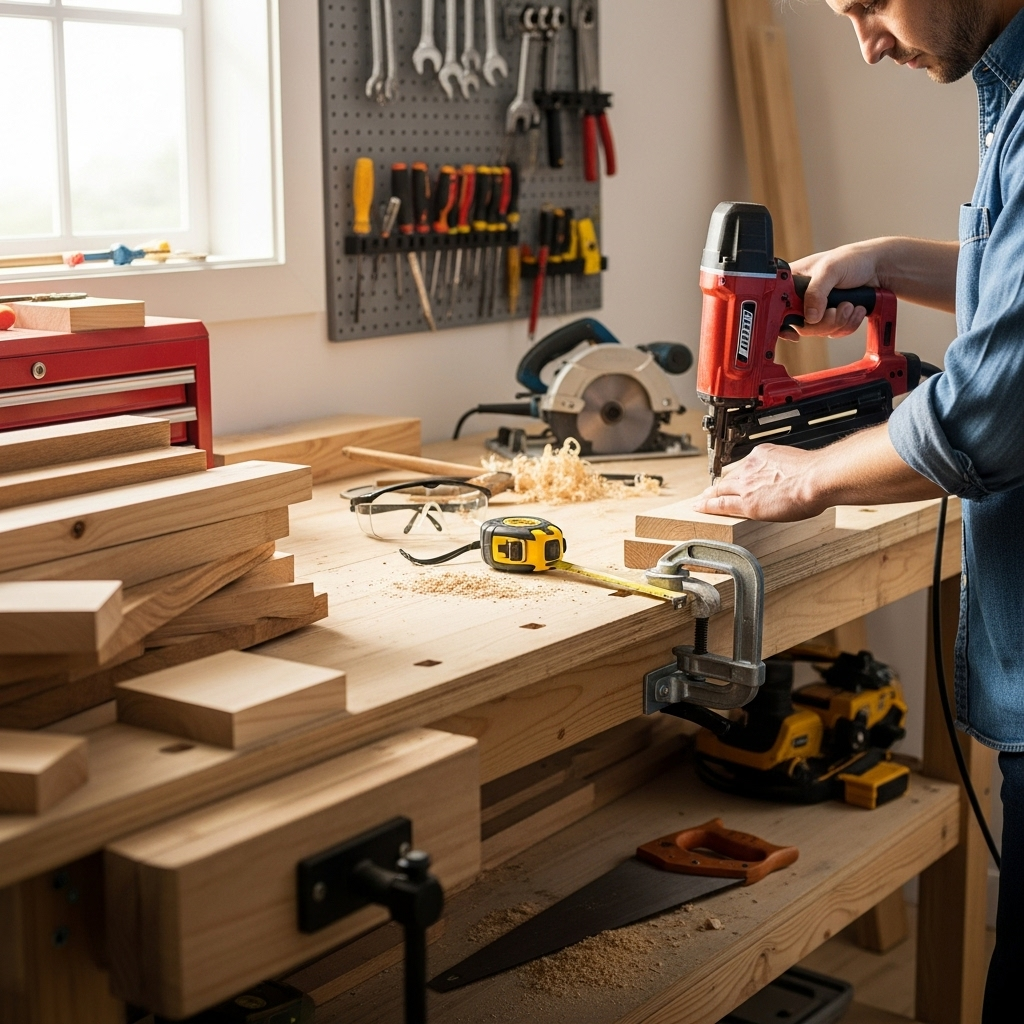Choosing the best nail gun brand for beginners means finding one that’s reliable, easy to use, safe, and fits your budget and DIY needs. Look for brands known for user-friendly designs, good customer support, and durability for your projects.
Are you ready to take your DIY projects to the next level with a nail gun? It’s a fantastic tool that can speed up your work and give your projects a professional finish. But stepping into the world of nail guns can feel a little overwhelming at first. With so many brands and types out there, how do you know which one is the best fit for you? Don’t worry, I’m Jack Shaffer, your go-to guy for all things nailing, and I’m here to make this choice simple. We’ll walk through everything you need to know, step by step, so you can pick a nail gun brand with confidence. Let’s get started!
Table of Contents
Why Choosing the Right Nail Gun Brand Matters
Picking the right nail gun brand isn’t just about getting a tool; it’s about investing in your DIY journey. A great brand means you’re likely getting a tool that’s reliable, safe, and built to last. For beginners, this is extra important. You want a tool that won’t fight you, that’s forgiving if you make a mistake, and that makes learning the ropes a positive experience. A good nailer will help you complete projects smoothly, saving you time and frustration. On the flip side, a poorly chosen brand might lead to jams, misfires, or even safety issues. We want to avoid that and get you set up for success!
Understanding Nail Gun Types: The First Step
Before we dive into brands, let’s quickly touch upon the different types of nail guns. Knowing which type you need will narrow down your brand search significantly.
Framing Nailers: These are powerful workhorses designed for heavy-duty tasks like building decks, framing houses, and other structural projects. They typically use larger nails.
Finish Nailers: Perfect for trim work, baseboards, and crown molding. They use smaller, thinner nails that are less likely to split wood and leave a cleaner finish.
Brad Nailers: Similar to finish nailers but use even smaller, thinner nails (brads). They are excellent for delicate trim, attaching small decorative pieces, and projects where minimal visible holes are desired.
Pin Nailers: These use very thin, headless pins, ideal for attaching very small moldings or where you want the nail hole to be virtually invisible.
Staple Guns (often grouped with nailers): While technically not nail guns, they use staples and are great for upholstery, fencing, or attaching sheathing.
For most DIY homeowners and beginners tackling furniture, trim, or lighter framing, a finish nailer or a brad nailer is often the best starting point.
Key Factors When Choosing a Nail Gun Brand for Beginners
When you’re just starting out, focusing on these core aspects of a nail gun brand will help you make a wise choice. Think of these as your checklist!
1. Reliability and Durability
You want a nail gun that works when you need it to, project after project. A reliable brand has a track record of producing tools that don’t break down easily. Look for brands that are known for:
Using quality materials in their tools.
Having fewer reported issues with jams or internal damage.
Good construction that feels solid in your hand.
You can often get a sense of this by reading reviews and asking for recommendations from fellow DIYers or experienced woodworkers.
2. Ease of Use
As a beginner, simplicity is key. The best brands for newcomers offer:
Ergonomic Design: Tools that feel comfortable to hold and maneuver, reducing fatigue during longer projects.
Intuitive Controls: Simple adjustments for depth and power, without overly complex settings.
Easy Jam Clearing: Most nail guns can jam, but a good brand makes it easy and quick to clear these jams without needing special tools or expertise.
Lightweight Options: Especially for finish and brad nailers, a lighter tool makes a big difference.
3. Safety Features
Safety is paramount when working with power tools. Reputable brands will incorporate safety features designed to protect you. Key features to look for include:
Contact Trip Safety Mechanism: This is a crucial safety feature that prevents the nail gun from firing unless the tip is pressed firmly against the surface. This prevents accidental firing.
No-Mar Nose Cap: A rubber or plastic tip on the nose of the gun protects your workpiece from scratches or dents, especially important for delicate trim work.
Depth Adjustment: The ability to control how deep the nail drives is not only about aesthetics but also safety. Driving nails too deep can cause damage or even split wood unexpectedly.
Always remember to read and follow the manufacturer’s safety instructions. For more on general tool safety, resources like the OSHA guidelines on power tools offer excellent advice.
4. Power Source and Convenience
Nail guns come in a few flavors based on how they’re powered:
Corded Electric: These require a power outlet and air compressor (for pneumatic models). They are generally reliable but can be less portable due to cords and hoses.
Cordless Battery-Powered: These offer great freedom of movement. They use rechargeable batteries and don’t require a compressor. They are often more expensive upfront but offer unbeatable convenience for many DIY tasks.
Pneumatic (Air-Powered): These are powered by an air compressor. They tend to be lighter, more powerful, and often more affordable than cordless models, but you need to invest in or have access to an air compressor, which adds to the overall cost and setup.
For beginners, cordless battery-powered models are often the most appealing due to their ease of setup and portability. However, if you already have or plan to get an air compressor for other tools, a pneumatic option can be a very cost-effective and robust choice.
5. Cost and Value
Nail guns vary widely in price. While it’s tempting to go for the cheapest option, remember that a slightly higher investment in a reputable brand can save you money in the long run through durability and fewer repairs. Consider:
Initial Purchase Price: What’s your budget?
Operating Costs: For pneumatic and corded electric tools, this includes the cost of an air compressor, hoses, or electricity. For cordless, it’s the battery and charger.
Longevity: How long will the tool likely last?
Warranty and Support: A good warranty offers peace of mind.
Look for brands that offer a good balance of quality, features, and price. Sometimes, buying a kit that includes batteries and a charger (for cordless) or essential accessories can offer better value.
6. Brand Reputation and Customer Support
A brand’s reputation speaks volumes. Look for brands that:
Are well-established in the power tool market.
Have positive reviews regarding customer service and warranty claims.
Offer readily available replacement parts and accessories.
Have accessible user manuals and online support.
Some brands are known for their professional-grade tools, while others focus more on the DIY market. For beginners, brands catering to the DIY segment often provide more features geared towards ease of use and affordability.
Top Nail Gun Brands for Beginners: A Closer Look
Based on the factors above, here are some of the most consistently recommended brands for beginners, along with what makes them stand out. These brands are generally available at major hardware stores and online retailers.
1. Ryobi (Battery-Powered Focus)
Strengths: Ryobi is fantastic for DIYers and beginners because of its extensive ONE+ battery system. If you buy a Ryobi cordless tool, you can use the same battery for dozens of other Ryobi tools, which is a huge cost-saver. Their nail guns are generally lightweight, easy to use, and perform well for common DIY tasks like trim, craft projects, and light framing. They offer a good balance of performance and affordability.
Ideal For: Homeowners, hobbyists, and DIYers who are building a cordless tool collection.
Consider if: You want convenience, tool interchangeability with batteries, and don’t need professional-grade heavy-duty performance for constant daily use.
2. DeWalt (Versatile Options, Cordless & Pneumatic)
Strengths: DeWalt is a trusted name in power tools, known for its durability and performance. They offer both excellent cordless (20V MAX system) and pneumatic options. Their cordless nailers are powerful and well-built, offering good battery life and performance that can rival some pneumatic models. Their pneumatic lines are also robust and reliable. DeWalt tools are built to last, making them a great long-term investment.
Ideal For: Beginners who want a tool that can grow with them as their skills and project complexity increase. Also good for those who already own DeWalt 20V MAX batteries.
Consider if: You prioritize longevity, power, and are willing to invest a bit more upfront for a tool that’s built for tougher jobs.
3. Milwaukee (High-Performance Cordless)
Strengths: Milwaukee is renowned for its M12 and M18 cordless tool systems, offering some of the most powerful and innovative battery-powered nailers on the market. Their FUEL technology delivers performance that often matches or exceeds pneumatic tools. They are robust, durable, and designed for demanding use. While often at a higher price point, their cordless nailers are incredibly convenient and powerful.
Ideal For: Serious DIYers and hobbyists who want top-tier cordless performance and precision, and are willing to invest in high-quality tools.
Consider if: You want the absolute best cordless performance and are invested in the Milwaukee battery ecosystem.
4. Bostitch (Pneumatic & Cordless Excellence)
Strengths: Bostitch has a long-standing reputation for pneumatic nailers, making them a go-to for many professionals. They offer a wide range of reliable and durable pneumatic options that are often more affordable than their professional counterparts. They also have a growing line of cordless tools that maintain that reputation for toughness and functionality.
Ideal For: Those looking for robust, reliable pneumatic tools, or solid cordless performance. Good value for money.
Consider if: You are looking for proven performance, especially in pneumatic models, and appreciate a brand with deep roots in nailing technology.
5. Metabo HPT (Formerly Hitachi) (Pneumatic Powerhouses)
Strengths: Metabo HPT (formerly Hitachi Power Tools) is known for its high-quality, durable pneumatic nailers. They are often praised for their reliability, driving power, and longevity. If you’re considering a pneumatic tool and want a workhorse that will last, Metabo HPT is a very strong contender. Their cordless offerings are also improving.
Ideal For: DIYers and hobbyists who are leaning towards pneumatic nailers for their power and cost-effectiveness (assuming they have or will get an air compressor).
Consider if: You want a powerful, reliable pneumatic nailer from a brand known for its robust engineering.
6. CRAFTSMAN (Budget-Friendly and Accessible)
Strengths: CRAFTSMAN offers a range of accessible and budget-friendly nail gun options, often available in convenient kits. They are a good choice for occasional DIY tasks where extreme precision or heavy-duty use isn’t required. They are widely available and offer a decent entry-level experience.
Ideal For: Beginners on a tight budget, or for very light, occasional DIY jobs.
Consider if: Your budget is a primary concern and your projects are not too demanding.
Comparing Nail Gun Brands: A Table
To help visualize the differences, here’s a quick comparison of some popular brands. This is a general guide, and specific models within a brand will vary.
| Brand | Primary Strength | Typical Price Range (Beginner-Friendly Models) | Battery System (if cordless) | Best For | Notes |
| :———– | :————————————- | :——————————————— | :————————— | :———————————————————————- | :————————————————————————– |
| Ryobi | Battery system, affordability, ease of use | $$ | ONE+ | Homeowners, first-time buyers, those building a cordless tool collection. | Excellent value; batteries are interchangeable across many tools. |
| DeWalt | Durability, performance, versatility | $$$ | 20V MAX | Serious DIYers, growing hobbyists who want a tool to last. | Great balance of power and longevity; strong cordless and pneumatic lines. |
| Milwaukee | High-performance cordless | $$$$ | M12 / M18 | Advanced DIYers, hobbyists seeking top-tier cordless power. | Premium choice; exceptional power and innovation in cordless technology. |
| Bostitch | Pneumatic reliability, value | $$ – $$$ | Varies | Those prioritizing pneumatic performance or solid cordless options. | A classic name in pneumatic; good all-around performance across types. |
| Metabo HPT | Robust pneumatic, longevity | $$ – $$$ | Varies | DIYers focused on pneumatic for power and consistent performance. | Known for very durable and powerful pneumatic tools. |
| CRAFTSMAN | Affordability, accessibility | $ | Varies | Budget-conscious DIYers, very occasional users. | Good entry-level option for light tasks. |
Price Range: $ (Budget-friendly) to $$$$ (Premium)
How to Choose Best Brand of Nail Gun: Step-by-Step Guide for Beginners
Ready to pick your nail gun? Follow these steps, and you’ll feel confident in your decision.
Step 1: Define Your Projects
What do you plan to build or repair?
Trim, molding, furniture building: You’ll likely need a brad nailer or finish nailer. Look for brands known for finer work and less damage to delicate materials.
Deck building, fencing, structural repairs: A framing nailer is what you need. These require more power and durability.
Upholstery, crafts, smaller projects: A pin nailer or even a heavy-duty stapler might be best.
Start with a general-purpose finish or brad nailer if you’re unsure. Many brands offer combo kits that can include both.
Step 2: Decide on Power Source
This is a big decision!
Cordless Battery: Most convenient, no compressor or cords. Great freedom. Check battery compatibility if you have other tools from a brand.
Pneumatic (Air): Requires an air compressor. Often more affordable (tool itself), lighter, and powerful. Good if you already own a compressor. You’ll need to factor in the cost of a compressor if you don’t. A good starter compressor might be around 2-6 gallons. For occasional DIY, Energy Star efficiency ratings for compressors can save on electricity.
Corded Electric: Less common for nail guns, usually for staplers.
For beginners seeking simplicity, cordless battery-powered is often the way to go.
Step 3: Set Your Budget
Be realistic about what you can spend.
Entry-level ($50 – $150): You might find basic pneumatic models or budget cordless kits. CRAFTSMAN, some basic Ryobi, or entry-level Bostitch could fit here.
Mid-range ($150 – $300): You’ll find solid cordless kits from Ryobi and DeWalt, and good pneumatic options from Bostitch and Metabo HPT. This is often the sweet spot for DIYers.
High-end ($300+): Premium cordless tools from DeWalt and Milwaukee, professional-grade pneumatic, or combo kits.
Remember to factor in the cost of accessories like batteries (if not included), nails, safety glasses, and potentially an air compressor and hose.
Step 4: Research Specific Models and Read Reviews
Once you’ve narrowed down the type, power source, and budget, dive into specific models.
Look at reputable retailers: Home Depot, Lowe’s, Amazon, tool specialty stores.
Read user reviews: Pay attention to comments about reliability, ease of use, jams, and customer support.
Watch video reviews: YouTube is an excellent resource for seeing tools in action and getting unbiased opinions, often from channels focused on DIY and woodworking.
Step 5: Check Warranties and Availability
Warranty: A good warranty (2-3 years is common for consumer-grade tools) shows the manufacturer stands behind their product.
Parts & Support: Can you easily find replacement parts or get help if something goes wrong? Brands with widespread availability usually have better support networks.
Step 6: Make Your Purchase and Practice!
After researching, trust your gut and make the purchase. The most important step now is to practice!
Read the Manual: Seriously, it has vital safety information and operating tips.
Practice on Scrap Wood: Get a feel for the tool’s power, depth, and how it handles different nail sizes before tackling your main project.
Frequently Asked Questions (FAQ)
Is a cordless battery-powered nail gun or a pneumatic nail gun better for a beginner?


